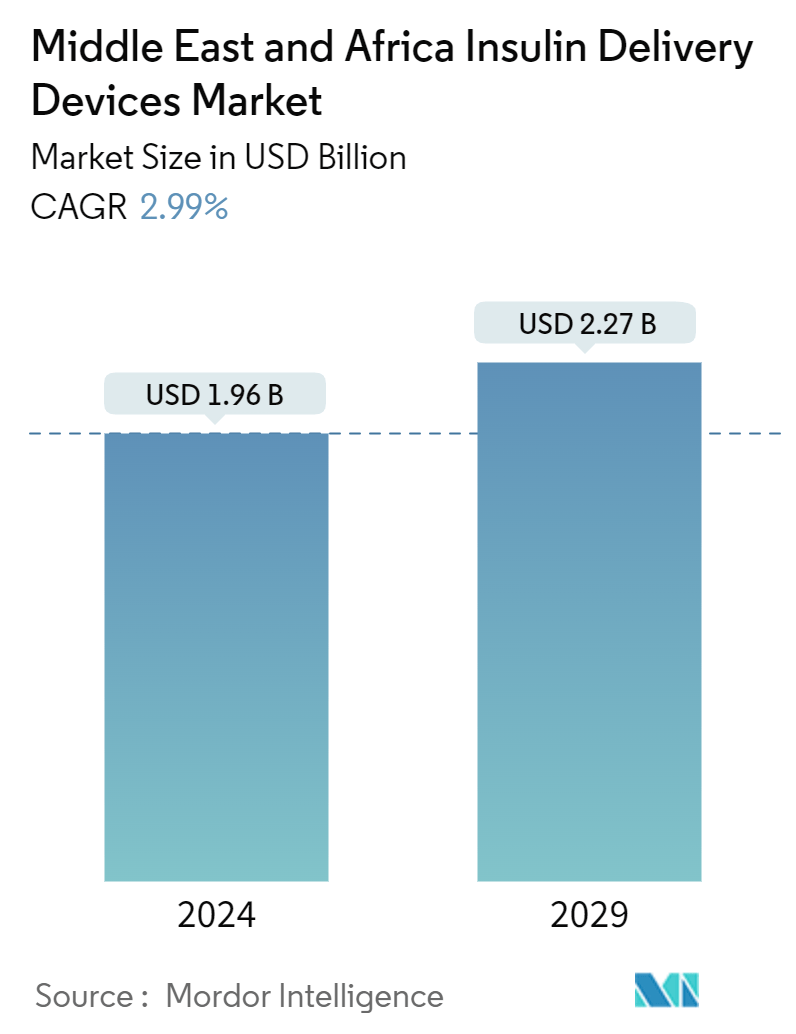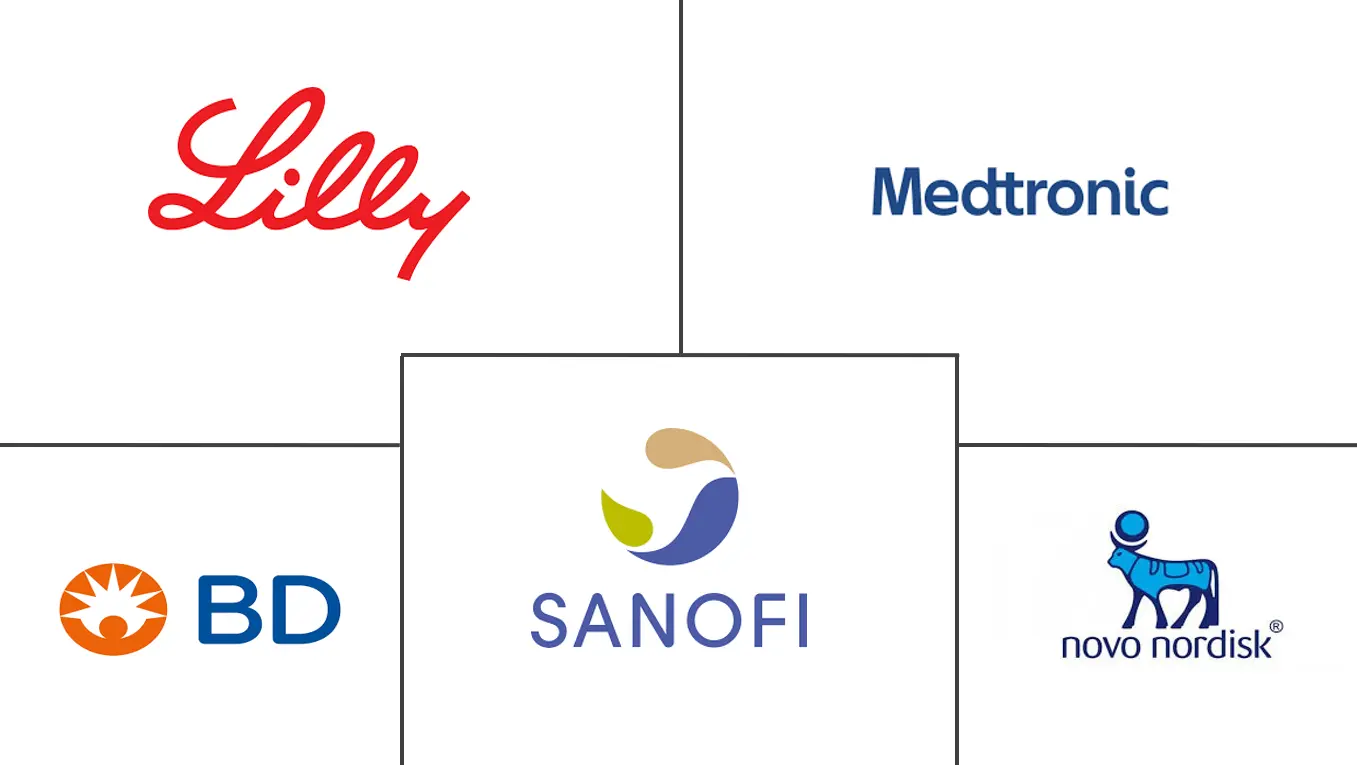Market Size of Middle East And Africa Insulin Delivery Devices Industry

| Study Period | 2018 - 2029 |
| Base Year For Estimation | 2023 |
| Forecast Data Period | 2024 - 2029 |
| Market Size (2024) | USD 1.96 Billion |
| Market Size (2029) | USD 2.27 Billion |
| CAGR (2024 - 2029) | 2.99 % |
Major Players
*Disclaimer: Major Players sorted in no particular order |
Need a report that reflects how COVID-19 has impacted this market and its growth?
Middle East And Africa Insulin Delivery Devices Market Analysis
The Middle East And Africa Insulin Delivery Devices Market size is estimated at USD 1.96 billion in 2024, and is expected to reach USD 2.27 billion by 2029, growing at a CAGR of 2.99% during the forecast period (2024-2029).
An insulin infusion pump works as an alternative to the traditional system of daily injections or an insulin pen. Insulin infusion pumps reduce the large swings in blood glucose levels, lessen pain, and deliver more accurately than injections. The scheduling of meal timings is not required when using pumps. This makes infusion pumps more user-friendly for patients. Insulin therapy is also known as continuous subcutaneous insulin infusion (CSII). It is an efficient and flexible method of insulin delivery.
The advancement of technology has greatly enhanced the effectiveness of insulin delivery devices, resulting in improved management of glucose levels. Despite this progress, a majority of individuals who require insulin still rely on traditional methods such as syringes or traditional pens. Engaging in a conversation with your healthcare provider regarding these modern devices could greatly simplify the process of administering insulin.
In recent decades, technological advancements and innovative solutions have paved the way for a variety of insulin delivery devices, aiming to alleviate the difficulties and burdens associated with insulin administration. These devices range from simple patches to automated insulin delivery (AID) systems. However, it is noteworthy that a significant portion of insulin users still opt for the traditional combination of insulin bottles, syringes, or conventional insulin pens.
Technological advancements have increased over the period in Insulin delivery devices for safer and more accurate administration of insulin. Medtronic launched an Extended infusion set that leverages advanced materials that help reduce insulin preservative loss and maintains insulin flow and stability. The set is compatible with all MiniMed 600 and 700 series insulin pumps. The new tubing connector improves the physical and chemical stability of insulin, reliability of infusion site performance, and reduces the risk of infusion set occlusion. In addition to the new infusion set, the Medtronic Extended reservoir is also tested and approved to keep insulin stable and safely used for up to 7 days.
Therefore, owing to the aforementioned factors the studied market is anticipated to witness growth over the analysis period.
Middle East And Africa Insulin Delivery Devices Industry Segmentation
There are different ways to inject insulin into a patient's body using syringes, pens, pumps, and jet injectors, giving them various options for insulin delivery. The Middle East and Africa insulin delivery devices market is segmented into type and geography. The report offers the value (in USD) and volume (in units) for the above segments.
| Type | |||||
| |||||
| Insulin Syringes | |||||
| Insulin Disposable Pens | |||||
| Insulin Cartridges in Reusable Pens | |||||
| Jet Injectors |
| Geography | |
| Egypt | |
| Iran | |
| Oman | |
| Rest of Middle East and Africa | |
| Saudi Arabia | |
| South Africa |
Middle East And Africa Insulin Delivery Devices Market Size Summary
The Middle East and Africa insulin delivery devices market is poised for growth, driven by technological advancements and increasing awareness of diabetes management. Insulin infusion pumps, which offer a more user-friendly and accurate alternative to traditional injection methods, are gaining traction due to their ability to reduce blood glucose fluctuations and eliminate the need for meal timing coordination. Despite the availability of these modern devices, a significant number of patients still rely on conventional methods such as syringes and insulin pens. This trend highlights the ongoing need for education and engagement with healthcare providers to encourage the adoption of advanced insulin delivery solutions. The market is characterized by a moderate level of consolidation, with major global players like Novo Nordisk, Sanofi, and Medtronic leading the charge, alongside regional companies.
The region faces a rising diabetes prevalence, prompting government initiatives to address the public health challenge. However, gaps remain in national policies and strategies to combat obesity and physical inactivity, which are key risk factors for diabetes. In countries like Iran, the economic impact of diabetes is significant, with rising mortality rates and high healthcare costs associated with diabetes-related complications. Despite these challenges, opportunities for market growth exist through the introduction of new products, international research collaborations, and increased diabetes awareness. Recent developments, such as PharmaSens's innovative insulin patch pump system and Novo Nordisk's trials with once-weekly insulin, underscore the dynamic nature of the market and the potential for continued expansion in the coming years.
Middle East And Africa Insulin Delivery Devices Market Size - Table of Contents
-
1. MARKET DYNAMICS
-
1.1 Market Overview
-
1.2 Market Drivers
-
1.3 Market Restraints
-
1.4 Porter's Five Forces Analysis
-
1.4.1 Bargaining Power of Suppliers
-
1.4.2 Bargaining Power of Consumers
-
1.4.3 Threat of New Entrants
-
1.4.4 Threat of Substitute Products and Services
-
1.4.5 Intensity of Competitive Rivalry
-
-
-
2. MARKET SEGMENTATION
-
2.1 Type
-
2.1.1 Insulin Pumps
-
2.1.1.1 Insulin Pump Device
-
2.1.1.2 Reservoir
-
2.1.1.3 Infusion Sets
-
-
2.1.2 Insulin Syringes
-
2.1.3 Insulin Disposable Pens
-
2.1.4 Insulin Cartridges in Reusable Pens
-
2.1.5 Jet Injectors
-
-
2.2 Geography
-
2.2.1 Egypt
-
2.2.2 Iran
-
2.2.3 Oman
-
2.2.4 Rest of Middle East and Africa
-
2.2.5 Saudi Arabia
-
2.2.6 South Africa
-
-
Middle East And Africa Insulin Delivery Devices Market Size FAQs
How big is the Middle East And Africa Insulin Delivery Devices Market?
The Middle East And Africa Insulin Delivery Devices Market size is expected to reach USD 1.96 billion in 2024 and grow at a CAGR of 2.99% to reach USD 2.27 billion by 2029.
What is the current Middle East And Africa Insulin Delivery Devices Market size?
In 2024, the Middle East And Africa Insulin Delivery Devices Market size is expected to reach USD 1.96 billion.

